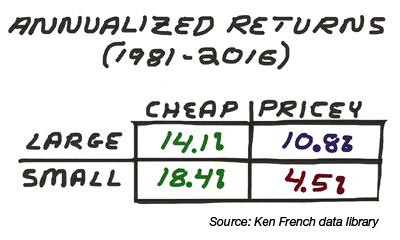Thursday, March 30, 2017
 Historically, small-cap stocks have outperformed large-cap stocks. This difference is referred to in investment circles as the small-cap (aka small-company) premium. The discovery of the small-cap premium is credited to Rolf Banz’s 1981 Journal of Financial Economics study, «The Relationship Between Return and Market Value of Common Stocks.» I specifically bring Banz’s study up because there has been a debate as to whether the publication of his study effectively destroyed the premium.
Historically, small-cap stocks have outperformed large-cap stocks. This difference is referred to in investment circles as the small-cap (aka small-company) premium. The discovery of the small-cap premium is credited to Rolf Banz’s 1981 Journal of Financial Economics study, «The Relationship Between Return and Market Value of Common Stocks.» I specifically bring Banz’s study up because there has been a debate as to whether the publication of his study effectively destroyed the premium.
Between 1927 and 1980, small-company stocks realized an annualized return of 17.1%. Over the same time period, large-company stocks gained 9.3% annually. Using the formula of small minus big results in a rounded premium of 7.7%.  (I’m using data from Dartmouth professor Kenneth French’s website for the smallest and biggest 30% of companies to calculate the returns.)
(I’m using data from Dartmouth professor Kenneth French’s website for the smallest and biggest 30% of companies to calculate the returns.)
During the subsequent period 1981-2016, small-company stocks realized an annualized return of 11.8% and large-company stocks have realized an annualized return of 11.7%. This is the argument for Banz’s study having ended the premium. These numbers do not tell the full story, however. Further analysis reveals a different picture.
Between 1927 and 1980, small-company growth stocks (those with priciest valuations as measured by the book-to-market ratio, which is the inverse of the price-to-book ratio) realized a rounded 1.8 percentage-point premium relative to large-company growth stocks (10.1% versus 8.4% annualized returns). This premium was reversed over the 1981-2016 period, with small-company growth stocks underperforming their large-company counterparts 4.5% to 10.8% on an annualized basis.
The reversal of fortune does not exist among value stocks, however. Small-company value stocks realized a 6.4 percentage-point premium over the large-company value stocks for the period of 1927 through 1980 (19.1% versus 12.7% annualized). During the latter period of 1981-2016, this premium has largely been maintained (18.4% versus 14.1% annualized).
What the data clearly shows is that the reward is in the small, value quadrant. Even with the post-Banz-study reduction, the premium for owning small-company value stocks remains significant: 4.3 percentage points over large-company value, 7.6 percentage points over large-company growth and 13.9 percentage points over small-company growth.
There are caveats to consider to before loading up the truck on small-company stocks. The premium requires patience and a lengthy time horizon to capture. Small-company stocks have also been more volatile than their large-company counterparts. (Over shorter periods of time, small-company growth and small-company value stocks will underperform, decline in value and otherwise fray your nerves. This is the case with all categories of stocks, including large, growth, dividend paying, momentum, etc.) Premiums from anomalies («factors») are realized by those investors with patience and the ability to stick with a strategy for the long term. If you don’t feel comfortable committing to one style of investing, you can always tilt your portfolio by allocating some of it to small-company stocks and allocating the remainder to other investment styles.